American actress Grace Kelly (1929-1982) had a brief but very successful Hollywood career. She was the sparkling, elegant heroin in three classic Alfred Hitchcock thrillers. Her talents rivalled her beauty, winning her a Best Actress Oscar for The Country Girl in 1954. Then Europe imported her. After marrying Prince Rainier III in April 1956, she became Princess of Monaco and retired from the cinema.
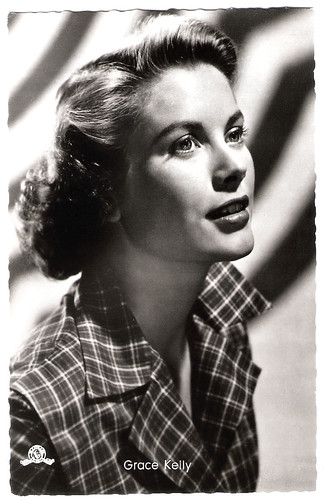
German postcard by Kolibri-Verlag G.m.b.H., Minden Westf., no. 1878. Photo: Metro-Goldwyn-Mayer. Publicity still for Mogambo (John Ford, 1953).

German postcard by Kolibri-Verlag G.m.b.H., Minden Westf., no. 1878. Photo: Paramount. Publicity still for Rear Window (Alfred Hitchcock, 1954).
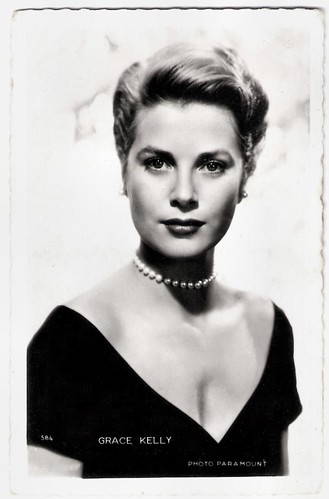
French postcard by Editions P.I., Paris, no. 584, Photo: Paramount, 1954.

French postcard by Editions du Globe, no. 498, Photo: Virgil Apger / Metro Goldwyn Mayer. Key-set portrait from High Society (Charles Walters, 1956).
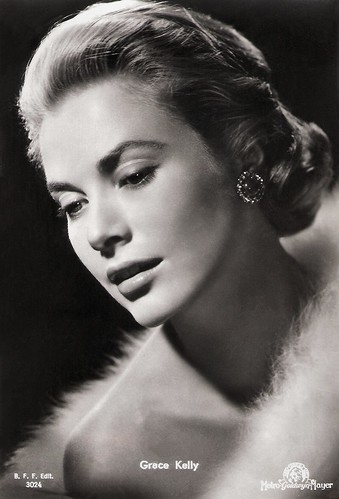
Italian postcard by B.F.F. Edit. (Ballerini & Fratini, Firenze), no. 3024. Photo: Metro-Goldwyn-Mayer.
Grace Patricia Kelly was born in 1929 in Philadelphia, Pennsylvania. She was the daughter of Margaret Katherine Majer, who had taught physical education at the University of Pennsylvania, and John Brendan Kelly, Sr., who owned a successful brickwork contracting company and was a three-time Olympic Gold winner for rowing. Her uncle was Pulitzer Prize-winning playwright George Kelly.
At an early age, Grace decided to become an actress. After her high school graduation in 1947, she struck out on her own, heading to New York. Despite her parents' disapproval, she attended and graduated from the American Academy of Dramatic Arts. She worked as a model and in 1949, she made her Broadway debut in a revival of August Strindberg's The Father alongside Raymond Massey.
At 19, her graduation performance was as Tracy Lord in The Philadelphia Story. Grace also made a foray into the infant medium of television and appeared in 60 live drama productions between 1950 and 1953. Her success on television brought her to the attention of Hollywood.
Her first film was Fourteen Hours (Henry Hathaway, 1951) when she was 22. It was a small part, but a start nonetheless. The following year, she landed the role of Amy Kane in the now-classic Western High Noon (Fred Zinnemann, 1952), opposite starring Gary Cooper. The film turned out to be very popular. Curiously, however, she did not benefit from the film's success, and no other offers were immediately forthcoming.
In 1953, Grace appeared in only one film, the popular jungle drama Mogambo (John Ford, 1953). She played Linda Nordley next to Clark Gable and Ava Gardner. Director John Ford said that she showed "breeding, quality and class." Her role won her a Golden Globe Award and an Academy Award nomination for Best Supporting Actress in 1954. Grace signed a seven-year contract with MGM.
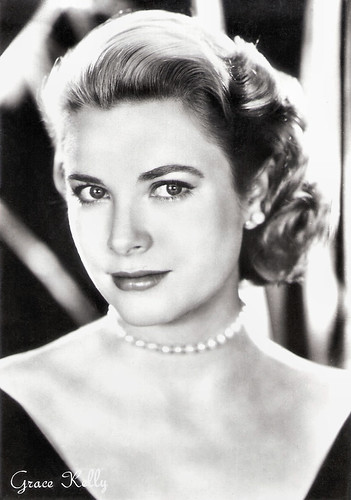
Italian postcard by Rotalfoto, Milano, no. 552.
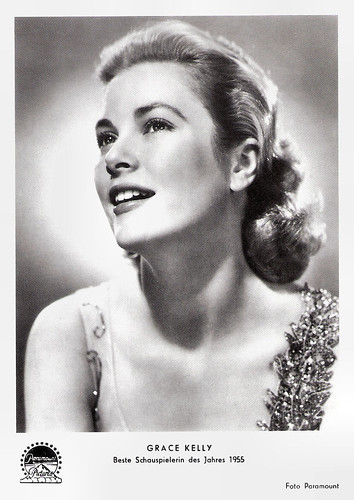
Modern German postcard by K & B / Filmwelt Berlin Archiv für Film-Geschichte, no. KB 55. Photo: Paramount. Publicity still for To Catch a Thief (Alfred Hitchcock, 1955). Caption: Best Actress of the Year 1955.
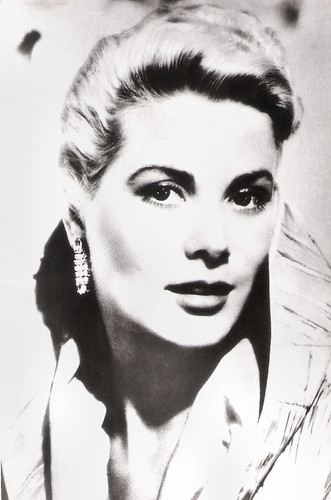
Yugoslavian postcard by Yugoturist, Beograd / Studio Sombor, no. 183.

West-German postcard by Kolibri-Verlag G.m.b.H., Minden (Westf.), no. F 38. Photo: Metro-Goldwyn-Mayer (MGM). Publicity still for High Society (Charles Walters, 1956).
It was master director Alfred Hitchcock who turned Grace Kelly into a major star. She was the perfect blonde he had been seeking throughout his career. Her first film for him was Dial M for Murder (Alfred Hitchcock, 1954), the screen adaptation of Frederick Knott's Broadway hit.
Then followed her standout performance as elegant socialite Lisa Fremont in the brilliant Rear Window (Alfred Hitchcock, 1954). She was cast opposite James Stewart, who played a photographer who witnesses a murder in an apartment across the courtyard while convalescing in a wheelchair. TCM: “The dazzlingly designed Hitchcock classic would be a showcase of Kelly's beauty and her true personality.”
In 1954 Kelly appeared in five films. She won the Academy Award for Best Actress for her portrayal of Georgie Elgin, the wife of a washed-up crooner (Bing Crosby) in The Country Girl (George Seaton, 1954) a film version of Clifford Odets' Broadway hit. William Holden played a director of a Broadway play, who falls for Kelly's character after casting her depressed and alcoholic husband, - an uncomfortable love triangle that mirrored real life. Reportedly Kelly had affairs with both Holden and Crosby.
In 1955, Grace teamed for the third and final time with Hitchcock on To Catch a Thief (Alfred Hitchcock, 1955), co-starring Cary Grant. Hal Erickson at AllMovie: “To Catch a Thief is actually as enjoyable and engaging now as it was 40 years ago. Though the Riviera location photography is pleasing, our favorite scene takes place in a Paramount Studios mockup of a luxury hotel suite, where Grant and Kelly make love while a fireworks display orgasmically erupts outside their window.”
In 1956, she again played Tracy Lord, now in the musical comedy High Society (Charles Walters, 1956), based on the Oscar winning comedy The Philadelphia Story (George Cukor, 1940). The whimsical tale ended with her re-marrying her former husband, played by Bing Crosby. The film was a hit but turned out to be her final acting performance.

Dutch postcard by Uitg. Takken, no. 3015. Photo: MGM. Publicity still for High Society (Charles Walters, 1956) with Bing Crosby.
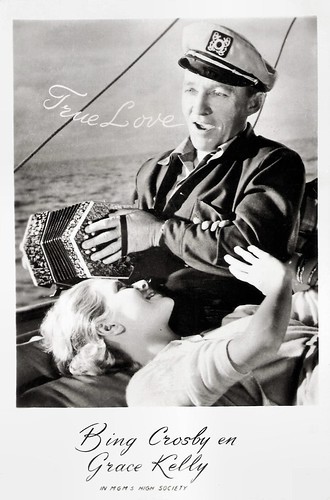
Dutch postcard by Uitg. Takken, Utrecht, no. 3021. Photo: Metro Goldwyn Mayer. Publicity still for High Society (Charles Walters, 1956) with Bing Crosby.

French postcard by Editions du Globe, Paris, no. 496. Photo: Metro Goldwyn Mayer. Publicity still for High Society (Charles Walters, 1956).
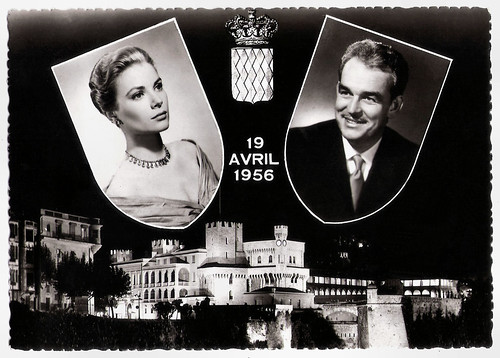
19 April 1956; the wedding with Prince Rainier of Monaco. Monegasque postcard by S.A.P.I., Monaco. Photos: Harcourt and Picédi.
In 1955, Grace Kelly had met Prince Rainier III of Monaco during the Cannes Film Festival. She broke off her affair with fashion designer Oleg Cassini to marry the Prince.
News of the engagement was a sensation. The lavish wedding in 1956 was estimated to have been watched by over 30 million viewers on live television.
Grace and Rainier had three children: Princess Caroline of Monaco (1957), Prince Albert of Monaco (1958) and Princess Stéphanie of Monaco (1965).
Reportedly, Grace hoped to return to acting in Alfred Hitchcock's Marnie (1964), but Monaco's citizens were outraged about the idea of their princess playing a kleptomaniac and kissing Sean Connery. So, Marnie premiered in 1964 with Tippi Hedren in the role intended for Kelly.
Prince Rainier later dismissed director Herbert Ross entreaties for Grace to star in his drama The Turning Point (1977). For the rest of her life, Grace was to remain in the news with her marriage and her three children. As Princess of Monaco, she retained her American roots, maintaining dual U.S. and Monegasque citizenship.
In 1982, Princess Grace died in Monaco, a day after suffering a stroke while driving, causing her to crash. She was 52. An estimated 100 million people viewed her funeral on TV. Rainier, who never remarried, was buried alongside her following his death in 2005.
Trailer Mogambo (1953). Source: Movieclips Trailer Vault (YouTube).
Trailer Dial M for Murder (1954). Source: Movieclips Trailer Vault (YouTube).
Trailer Rear Window (1954). Source: Movieclips Trailer Vault (YouTube).
Trailer High Society (1956). Source: Movieclips Trailer Vault (YouTube).
Sources: Denny Jackson and Dale O'Connor (IMDb), Pedro Borges (IMDb), Jason Ankeny (AllMovie), Hal Erickson (AllMovie), TCM, Wikipedia and IMDb.

German postcard by Kolibri-Verlag G.m.b.H., Minden Westf., no. 1878. Photo: Metro-Goldwyn-Mayer. Publicity still for Mogambo (John Ford, 1953).

German postcard by Kolibri-Verlag G.m.b.H., Minden Westf., no. 1878. Photo: Paramount. Publicity still for Rear Window (Alfred Hitchcock, 1954).

French postcard by Editions P.I., Paris, no. 584, Photo: Paramount, 1954.

French postcard by Editions du Globe, no. 498, Photo: Virgil Apger / Metro Goldwyn Mayer. Key-set portrait from High Society (Charles Walters, 1956).

Italian postcard by B.F.F. Edit. (Ballerini & Fratini, Firenze), no. 3024. Photo: Metro-Goldwyn-Mayer.
Breeding, quality and class
Grace Patricia Kelly was born in 1929 in Philadelphia, Pennsylvania. She was the daughter of Margaret Katherine Majer, who had taught physical education at the University of Pennsylvania, and John Brendan Kelly, Sr., who owned a successful brickwork contracting company and was a three-time Olympic Gold winner for rowing. Her uncle was Pulitzer Prize-winning playwright George Kelly.
At an early age, Grace decided to become an actress. After her high school graduation in 1947, she struck out on her own, heading to New York. Despite her parents' disapproval, she attended and graduated from the American Academy of Dramatic Arts. She worked as a model and in 1949, she made her Broadway debut in a revival of August Strindberg's The Father alongside Raymond Massey.
At 19, her graduation performance was as Tracy Lord in The Philadelphia Story. Grace also made a foray into the infant medium of television and appeared in 60 live drama productions between 1950 and 1953. Her success on television brought her to the attention of Hollywood.
Her first film was Fourteen Hours (Henry Hathaway, 1951) when she was 22. It was a small part, but a start nonetheless. The following year, she landed the role of Amy Kane in the now-classic Western High Noon (Fred Zinnemann, 1952), opposite starring Gary Cooper. The film turned out to be very popular. Curiously, however, she did not benefit from the film's success, and no other offers were immediately forthcoming.
In 1953, Grace appeared in only one film, the popular jungle drama Mogambo (John Ford, 1953). She played Linda Nordley next to Clark Gable and Ava Gardner. Director John Ford said that she showed "breeding, quality and class." Her role won her a Golden Globe Award and an Academy Award nomination for Best Supporting Actress in 1954. Grace signed a seven-year contract with MGM.

Italian postcard by Rotalfoto, Milano, no. 552.

Modern German postcard by K & B / Filmwelt Berlin Archiv für Film-Geschichte, no. KB 55. Photo: Paramount. Publicity still for To Catch a Thief (Alfred Hitchcock, 1955). Caption: Best Actress of the Year 1955.

Yugoslavian postcard by Yugoturist, Beograd / Studio Sombor, no. 183.

West-German postcard by Kolibri-Verlag G.m.b.H., Minden (Westf.), no. F 38. Photo: Metro-Goldwyn-Mayer (MGM). Publicity still for High Society (Charles Walters, 1956).
Hitchcock's perfect blonde
It was master director Alfred Hitchcock who turned Grace Kelly into a major star. She was the perfect blonde he had been seeking throughout his career. Her first film for him was Dial M for Murder (Alfred Hitchcock, 1954), the screen adaptation of Frederick Knott's Broadway hit.
Then followed her standout performance as elegant socialite Lisa Fremont in the brilliant Rear Window (Alfred Hitchcock, 1954). She was cast opposite James Stewart, who played a photographer who witnesses a murder in an apartment across the courtyard while convalescing in a wheelchair. TCM: “The dazzlingly designed Hitchcock classic would be a showcase of Kelly's beauty and her true personality.”
In 1954 Kelly appeared in five films. She won the Academy Award for Best Actress for her portrayal of Georgie Elgin, the wife of a washed-up crooner (Bing Crosby) in The Country Girl (George Seaton, 1954) a film version of Clifford Odets' Broadway hit. William Holden played a director of a Broadway play, who falls for Kelly's character after casting her depressed and alcoholic husband, - an uncomfortable love triangle that mirrored real life. Reportedly Kelly had affairs with both Holden and Crosby.
In 1955, Grace teamed for the third and final time with Hitchcock on To Catch a Thief (Alfred Hitchcock, 1955), co-starring Cary Grant. Hal Erickson at AllMovie: “To Catch a Thief is actually as enjoyable and engaging now as it was 40 years ago. Though the Riviera location photography is pleasing, our favorite scene takes place in a Paramount Studios mockup of a luxury hotel suite, where Grant and Kelly make love while a fireworks display orgasmically erupts outside their window.”
In 1956, she again played Tracy Lord, now in the musical comedy High Society (Charles Walters, 1956), based on the Oscar winning comedy The Philadelphia Story (George Cukor, 1940). The whimsical tale ended with her re-marrying her former husband, played by Bing Crosby. The film was a hit but turned out to be her final acting performance.

Dutch postcard by Uitg. Takken, no. 3015. Photo: MGM. Publicity still for High Society (Charles Walters, 1956) with Bing Crosby.

Dutch postcard by Uitg. Takken, Utrecht, no. 3021. Photo: Metro Goldwyn Mayer. Publicity still for High Society (Charles Walters, 1956) with Bing Crosby.

French postcard by Editions du Globe, Paris, no. 496. Photo: Metro Goldwyn Mayer. Publicity still for High Society (Charles Walters, 1956).

19 April 1956; the wedding with Prince Rainier of Monaco. Monegasque postcard by S.A.P.I., Monaco. Photos: Harcourt and Picédi.
A lavish wedding watched by 30 million viewers
In 1955, Grace Kelly had met Prince Rainier III of Monaco during the Cannes Film Festival. She broke off her affair with fashion designer Oleg Cassini to marry the Prince.
News of the engagement was a sensation. The lavish wedding in 1956 was estimated to have been watched by over 30 million viewers on live television.
Grace and Rainier had three children: Princess Caroline of Monaco (1957), Prince Albert of Monaco (1958) and Princess Stéphanie of Monaco (1965).
Reportedly, Grace hoped to return to acting in Alfred Hitchcock's Marnie (1964), but Monaco's citizens were outraged about the idea of their princess playing a kleptomaniac and kissing Sean Connery. So, Marnie premiered in 1964 with Tippi Hedren in the role intended for Kelly.
Prince Rainier later dismissed director Herbert Ross entreaties for Grace to star in his drama The Turning Point (1977). For the rest of her life, Grace was to remain in the news with her marriage and her three children. As Princess of Monaco, she retained her American roots, maintaining dual U.S. and Monegasque citizenship.
In 1982, Princess Grace died in Monaco, a day after suffering a stroke while driving, causing her to crash. She was 52. An estimated 100 million people viewed her funeral on TV. Rainier, who never remarried, was buried alongside her following his death in 2005.
Trailer Mogambo (1953). Source: Movieclips Trailer Vault (YouTube).
Trailer Dial M for Murder (1954). Source: Movieclips Trailer Vault (YouTube).
Trailer Rear Window (1954). Source: Movieclips Trailer Vault (YouTube).
Trailer High Society (1956). Source: Movieclips Trailer Vault (YouTube).
Sources: Denny Jackson and Dale O'Connor (IMDb), Pedro Borges (IMDb), Jason Ankeny (AllMovie), Hal Erickson (AllMovie), TCM, Wikipedia and IMDb.
No comments:
Post a Comment